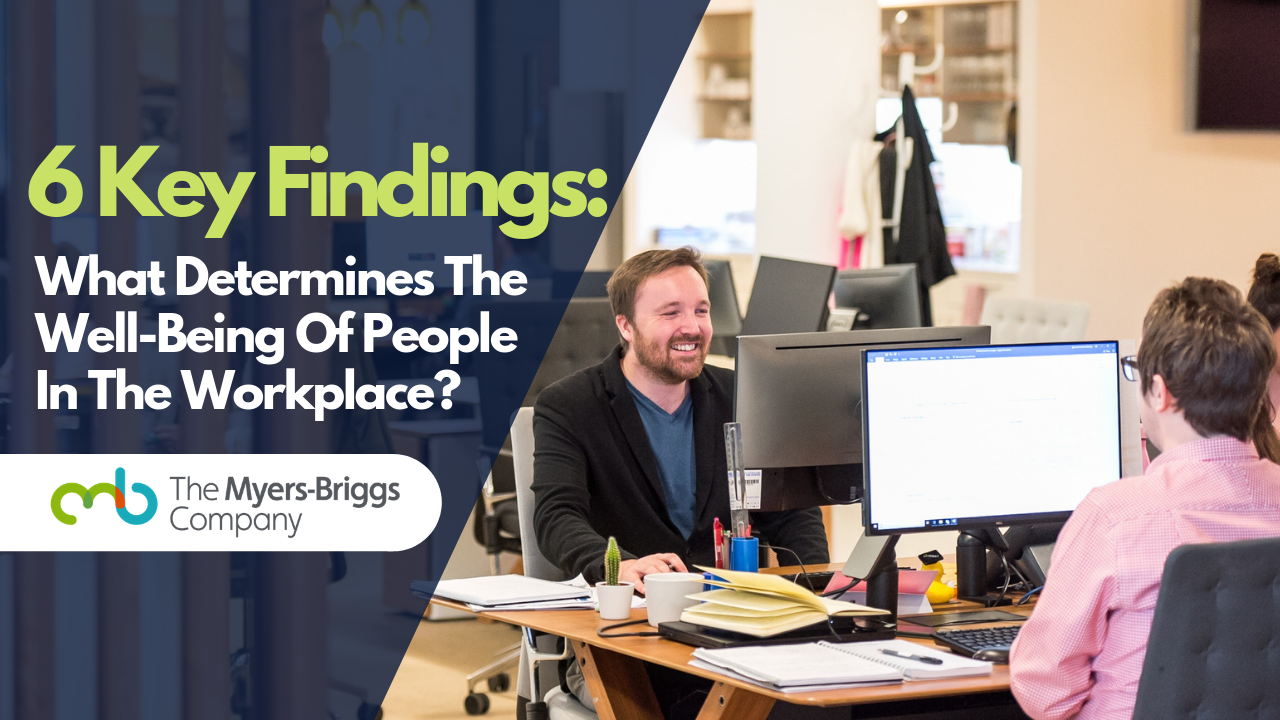The results of a three-year study on workplace well-being have been released.
The Myers-Briggs Company wanted to find out what determines the well-being of people in the workplace.
Here are 6 key findings from the report, along with tips on how companies can improve their wellness offering.
A recent report, “Well-being in the workplace: Why it matters for organizational performance and how to improve it” by The Myers-Briggs Company, investigated workplace well-being, the most effective activities to enhance wellness, and the organizational benefits of fostering wellness.
The investigation lasted for three years, and the results suggest that workplace wellness comprises the following factors:
- Positive Emotions – frequent feelings of happiness, contentment, pleasure
- Relationships – mutual feelings of caring, support, satisfaction
- Engagement – deep psychological connection and absorption in an activity or cause
- Meaning – having a sense of purpose and direction
- Accomplishment – pursuing success or mastery for its own sake
- Negative Emotions – low levels of anxiety, pessimism, depression.
The study involved 10,000 people from 131 countries with 16 Myers-Briggs Personality Types, and it was carried out from 2016 to 2018. The study analyzed the relationship between corporate wellness and organizational outcomes.
Key Findings
1. It’s about community
The relationship factor was consistently rated the highest aspect of well-being over the three years of research. Workers want supportive, authentic, and meaningful relationships in the workplace. These types of relationships can help foster more collaboration and have been associated with increased happiness levels.
2. We need to focus more on positive emotions
Positive emotions were the lowest rated aspect of well-being by the study participants. In the workplace, people are experiencing less often feelings of optimism, contentment, happiness, and satisfaction than they do feelings of meaning or accomplishments. Because positive emotions can improve motivation, inspiration, creativity, and productivity, the report argues that positive emotions present a “significant area for improvement”.
3. We’re getting better at being well at work
The study found that most people experience positive well-being at work. Australia, New Zealand, and Latin America reported the highest levels of well-being, while Asia and North America reported the lowest levels.
4. Gender and age differences
The study found that women and men experience similar levels of workplace wellness. However, women reported slightly higher levels of engagement and positive emotions. Men also report lower levels of meaning and accomplishment.
The study found that the younger they are, the less well they feel. “Well-being increases with age, with the youngest age group (18-24) reporting the lowest levels of well-being and the oldest age group (65+) reporting the highest levels.” These findings align well with the hypothesis that “people develop ways to support their well-being with experience”.
5. Occupation matters
Occupation matters, and the industry you work in influences your feelings of wellbeing. The study found “notable differences in the level of well-being between some occupations.” Individuals whose occupation involves service-related work reported higher well-being (education and training, healthcare practitioners, technical occupations, community and social services.)
In contrast, individuals whose occupation involves more practical and physically oriented work (food preparation and service, production, personal care and service) reported lower levels of well-being.
6. Well-being is good for individuals and companies
“Higher levels of workplace well-being related to higher levels of job satisfaction, normative (obligation to remain with the organization) and affective (emotional attachment and identification with the organization) commitment.”
Furthermore, the more well a worker feels, the more likely they are to engage in citizenship behaviors like helping coworkers, contribute to organizational objectives, and stay with the same organization.
How to Improve Corporate Wellness
According to the report, the most effective activities for well-being at work include:
- Focusing on tasks that interest people
- Focusing on a work task that makes people feel positive
- Undertaking work when they learn something new
- Taking breaks when needed
- Undertaking challenging work that helps people develop new skills and acquire new knowledge


 Dr. Gleb Tsipursky – The Office Whisperer
Dr. Gleb Tsipursky – The Office Whisperer Nirit Cohen – WorkFutures
Nirit Cohen – WorkFutures Angela Howard – Culture Expert
Angela Howard – Culture Expert Drew Jones – Design & Innovation
Drew Jones – Design & Innovation Jonathan Price – CRE & Flex Expert
Jonathan Price – CRE & Flex Expert













